
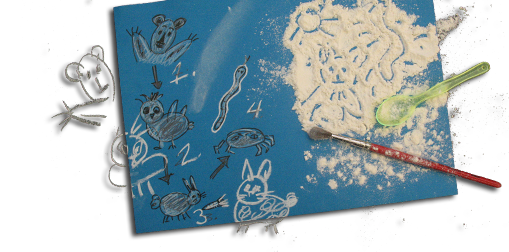



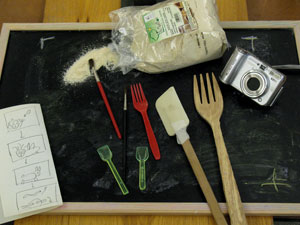
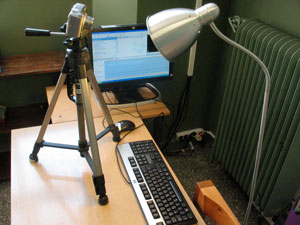
- Flour
- Dark colored cardboard or a dark, smooth surface
- Various household items, such as brushes, a fork, a cooking spatula
- Adhesive tape
- Digital photo camera
- Tripod
- Computer with installed video editing software
- Lighting fixtures – table or floor lamp (optional)


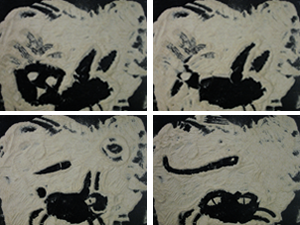
- To produce a moving image film using flour sprinkle a flat surface with flour and draw an image with your fingers or tools. Because flour is white it’s best to have dark background surface.
- You will change your image a little bit and then take a photograph. You keep doing this again and again throughout the procedure of creating you film. You will not need to have prepared drawings, characters, figures or objects as for the other moving image techniques. However, you might want to make rough sketches and drawings on a separate piece of paper to plan your sequence and guide you along.
Moving imaging with flour is an ideal technique for what is called metamorphosis and, in Greek, means transformation.It is very simple to transform a bear into an owl and then into a bird and then a rabbit that will end up being a crab… - Before starting you will have to think hard on what you want to do. The first few times you might just want to play around, altering your image constantly and taking a photograph after of each change. Then, when you are more experienced with the technique, try more complex ideas.

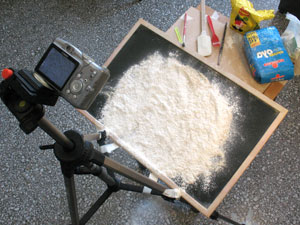
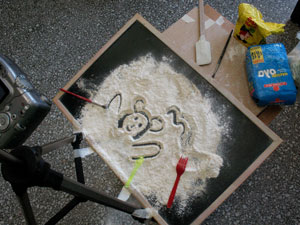
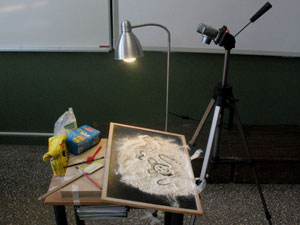
.jpg)
.jpg)
- You can sprinkle the flour directly on the table if the surface is dark. Otherwise use a dark, smooth cardboard taped on to the table top.
- Mount your camera on to the tripod. Adjust the tripod facing downwards towards the cardboard surface. Look into the camera screen. Mark the rectangle that corresponds to what you see in your screen.
Within this frame you can play around with flour, creating and transforming your image. If your the frame is too small, adjust the tripod so that the camera is higher up. If t is too big, adjust the tripod so that the camera is closer to your cardboard.
 Try using the camera zoom to get closer or move away from your cardboard.
Try using the camera zoom to get closer or move away from your cardboard.
If you can’t avoid seeing the tripod legs in the camera screen, try tilting the surface on which you will create your flour image and then tilt your camera by adjusting the tripod.
- Spend some time on the lighting. Make sure that no surrounding objects, the tripod or even you are casting shadows on your cardboard surface. If you want you can try lighting your flour image with a portable lamp on one side. Look at the shadows created by the light on your image. At the beginning it is better to avoid dark shadows. Later, with time and experience, you will be able to use shadows as part of your image.
 Make sure your lighting is constant. All photographs should have the same lighting to make sure that some are not brighter than others.
Make sure your lighting is constant. All photographs should have the same lighting to make sure that some are not brighter than others. - When everything is ready and set up, it’s time to start photographing!
You’ve already read Before Starting, so you know that while photographing your cardboard surface, the camera and tripod have to be absolutely stable. Watch out! It’s easy to kick the table or tripod by accident.
Sprinkle the flour on to your cardboard or table surface. Make a drawing with your fingers. Photograph the image. Slightly transform your drawing and take the next photo. Change your drawing again and continue photographing. Don’t forget: gradually transform your image, the changes between photographs should not be too big.
 It is much easier and fun to work with friends! If there are two of you, one can take the photographs and the other change the drawing. If you are three, one can take the photos while the other two each transform one part of the drawing.
It is much easier and fun to work with friends! If there are two of you, one can take the photographs and the other change the drawing. If you are three, one can take the photos while the other two each transform one part of the drawing.
When you have finished photographing and changing your drawing, remove the camera from the tripod. Transfer your photos into a folder in your computer.
 It is a good idea to name your project folder with a name which reminds you of the activity involved as e.g. flower – face.
It is a good idea to name your project folder with a name which reminds you of the activity involved as e.g. flower – face. Your flour drawing appears to move when you view the photos you took very quickly one after the other.
For this you will need to use video editing software. Many computers have this software already installed and, if not include a program that can be downloaded from the internet. Read about how to edit your film in the Before Starting chapter.




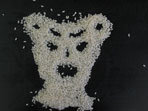
- Instead of flour, you can use sand, lentils, cocoa or whatever you might think of, but better not use more than one at the same time. If you do, you might end up with a confusing image
- You could try uing more than one material once you are more experienced with the technique.

On the left are examples of drawn animation projects created by primary school children in workshops led by Christina dePian.
Bellow, are links to examples of short animation videos on the internet created by children, students and/or amateurs. Further down, are examples of work by professionals and some classics of drawn animation.
Have a look and use these videos as a sourse of inspiration and ideas.
Contact us when you have created your own animation projects.
We are looking forward to seeing them!
Videos creted by children, students and amateurs:
